by Cayla Iske, PhD, and Kellie Hayden
Updated: June 6, 2025
Like guinea pigs and chinchillas, about 70% of a rabbit’s diet should be high-quality grass hay paired with 20% of a species-and-age-specific pelleted food, plus 8-10% greens and veggies. Dark leafy greens should make up the majority of the “greens and veggies” category of your rabbit’s diet, and fruits should be offered infrequently in very small amounts.

Keep in mind that every animal is an individual and unique in their nutritional needs. Please consult your veterinarian to determine the best diet percentages for your individual pet, especially if your little one has known health concerns.
While it may be a smaller overall percentage of the daily diet, leafy greens and vegetables are a critical part of your rabbit’s daily diet. Greens and veggies are loaded with incredible nutrients such as vitamins, minerals, and antioxidants. They also contain water and help provide hydration to your little ones.
The wide variety of greens and veggies available at the supermarket provides a convenient way to diversify your pet’s diet, as well as offer mental and nutritional enrichment to keep your bun interested at mealtime.
How Much Leafy Greens and Vegetables Should Rabbits Eat?
General feeding recommendations are around 1 cup of dark, leafy greens per 2 pounds of a rabbit’s body weight daily. While non leafy greens like bell peppers and cucumbers can be safely offered, vegetables tend to be higher in simple carbohydrates like sugar and starch and should be provided in smaller quantities. For non-leafy green veggies, provide about 1 tablespoon per 2 pounds of body weight per day.
For example, a rabbit that weighs 3 pounds should get roughly 1.5 cups of leafy greens and 1.5 tablespoons of non-leafy greens daily.
If available, organic produce is preferred to avoid pesticides. Regardless of whether produce is organic or not, all produce should be washed thoroughly with water before offering to your pet. While there are no known RHDV2 cases that have occurred through the spread of the virus via produce, produce is frequently grown outdoors and comes into contact with animals that roam outdoors. Harmful bacteria, viruses, and pathogens can reside on the surfaces of fresh greens and vegetables via soil residue.
Rabbit Daily Dietary Requirements Based on Weight
Rabbit Weight (lbs.) | Hay and Water | Pellets (Cups) | Leafy Greens (Cups) | Vegetables (Tbsps.) |
| 1 | Unlimited | 1/8 | 0.5 | 0.5 |
| 2 | Unlimited | 1/8 | 1.0 | 1.0 |
| 3 | Unlimited | 1/8 | 1.5 | 1.5 |
| 4 | Unlimited | 1/8 | 2.0 | 2.0 |
| 5 | Unlimited | 1/4 to 1/3 | 2.5 | 2.5 |
| 6 | Unlimited | 1/4 to 1/3 | 3.0 | 3.0 |
| 7 | Unlimited | 1/4 to 1/3 | 3.5 | 3.5 |
| 8 | Unlimited | 1/3 to 1/2 | 4.0 | 4.0 |
| 9 | Unlimited | 1/3 to 1/2 | 4.5 | 4.5 |
| 10 | Unlimited | 1/3 to 1/2 | 5.0 | 5.0 |
| 11 | Unlimited | 3/4 | 5.5 | 5.5 |
| 12 | Unlimited | 3/4 | 6.0 | 6.0 |
| 13 | Unlimited | 3/4 | 6.5 | 6.5 |
| 14 | Unlimited | 3/4 | 7.0 | 7.0 |
| 15 | Unlimited | 3/4 | 7.5 | 7.5 |
What Greens Can Rabbits Eat?
Wondering what greens rabbits can eat? The safest and most nutritious greens include romaine lettuce, arugula, dandelion greens, and cilantro. These leafy options are rich in fiber and essential nutrients that support digestion and overall wellness.
When feeding greens, it’s best to rotate a variety throughout the week. Offer 3 to 5 different types daily for enrichment and balanced nutrition. Introduce new greens gradually and observe your rabbit for any signs of digestive upset.
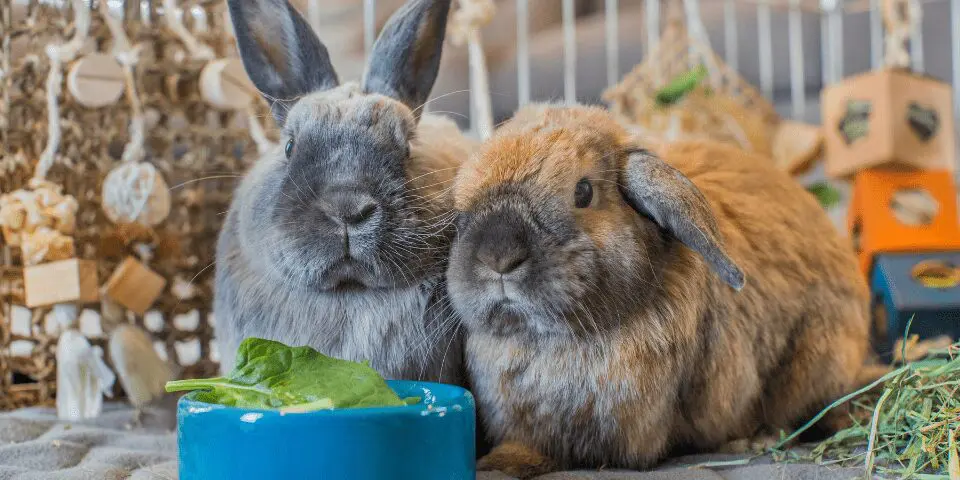
What are the Benefits of Fresh Greens and Veggies for Rabbits?
Greens and veggies are excellent sources of vitamins A, B, C, and K. They also provide soluble fiber and trace minerals such as iron, manganese, copper, and zinc.
The truly unique contribution of these dietary items, however, are the phytonutrients which are only found in plants. There are more than 25,000 phytonutrients found in plant-based ingredients including flavonoids and carotenoids, to name a few. Phytonutrients help to protect the body from stress, boost the immune system, and mitigate some issues commonly associated with aging animals, such as joint or skin and coat health concerns.
Many greens and veggies have similar nutritional compositions, but they can be quite unique in aroma, taste, and textures. Because of this, you should try different varieties and combinations to find out what your pet likes! We encourage providing 3 to 5 different types of greens and veggies daily.
You should rotate varieties weekly for nutritional enrichment opportunities. Greens and veggies can be offered all at once, but it’s best to divide them into multiple daily feedings if possible (e.g., a “breakfast” and “dinner”). This maximizes enrichment, increases interaction opportunities between you and your little one, and helps avoid GI upset due to rapid food intake.
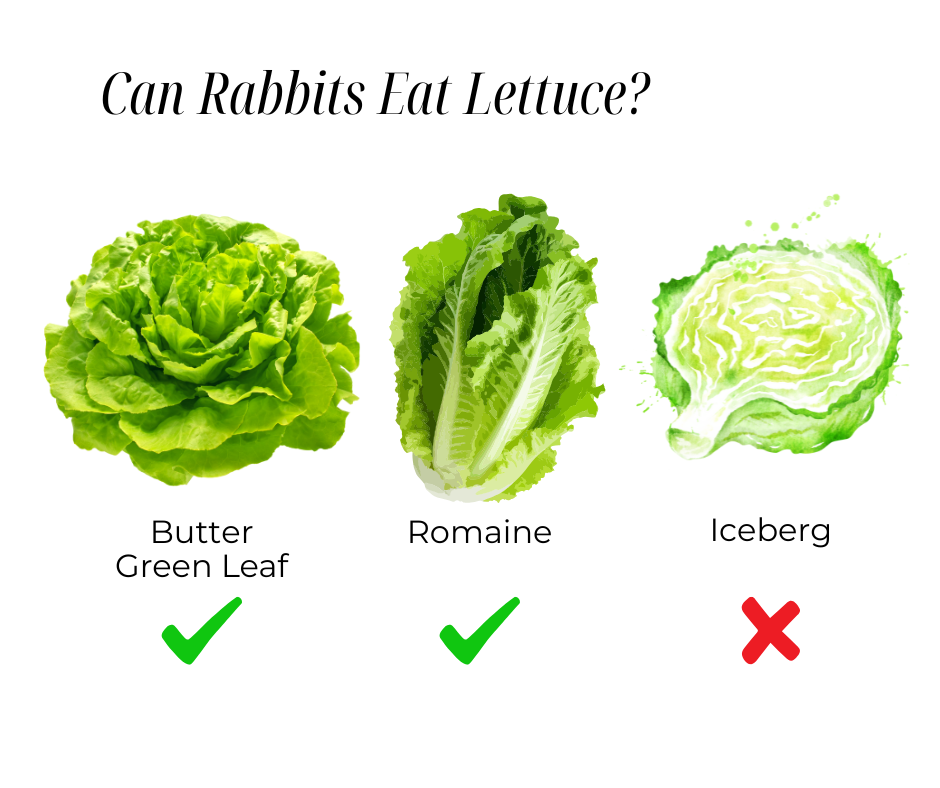
Can Rabbits Eat Lettuce?
Yes, rabbits can eat lettuce, but not all types are ideal. Romaine, green leaf, and butterhead lettuces are great choices, while iceberg lettuce should be avoided due to its low nutritional value and high water content, which may cause digestive upset.
Which Greens and Veggies are Best for Rabbits?
Some of the best leafy greens and vegetables for rabbits include lettuce, spinach, kale, bell peppers, and squash. While many greens and vegetables are rabbit-safe, rabbits should not eat iceberg lettuce, rhubarb, and raw onions, leeks, or garlic.
Even rabbit-safe foods can cause gastrointestinal distress if you introduce them to your rabbit too quickly. Gradual introduction of any new food item is critical to avoid upsetting your bunny’s digestive tract.
Never introduce more than one new food item at a time. Start with very small amounts and slowly increase it over time. Monitor your pet for any changes in attitude, appetite, or stool production.
Below, we’ve compiled a list of safe greens and veggies for your rabbit. While not exhaustive, this list should give pet parents plenty of options for bunny diets!
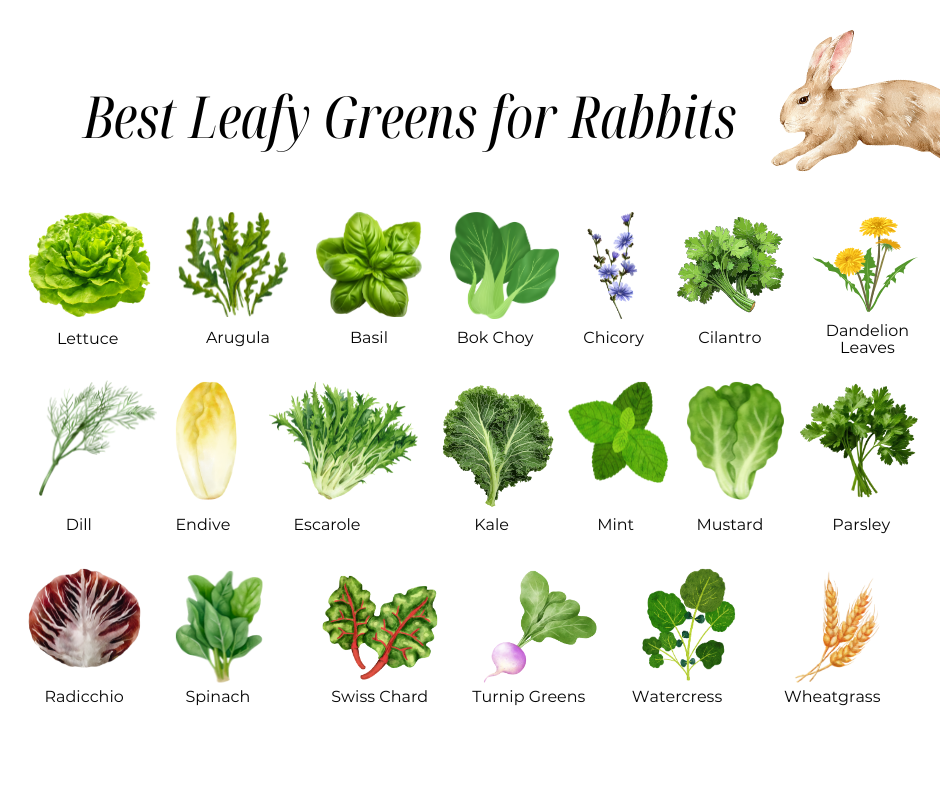
Best Leafy Greens for Rabbits
Type of Leafy Green | Calcium Concentrations (percentage) | Oxalate Concentrations (mg/kg (ppm)) | Note |
| Leafy Green Lettuce (Romaine, Butterhead, Bibb) | 0.035% | 0 | |
| Red or Green Leaf Lettuce | 0.037% | 0 | |
| Arugula | 0.160% | 0 | |
| Basil | 0.175% | 1250 | Feed sparingly or avoid completely for rabbits with bladder issues |
| Bok Choy | 0.105% | 0 | |
| Chicory | 0.015% | 2050 | Feed sparingly or avoid completely for rabbits with bladder issues |
| Cilantro | 0.070% | 50 | |
| Dandelion Leaves | 0.185% | 1000 | |
| Dill leaves | 0.210% | 1000 | |
| Endive | 0.053% | 0 | |
| Escarole | 0.095% | 400 | |
| Kale (all types) | 0.255% | 25 | |
| Mint | 0.200% | 350 | |
| Mustard Greens | 0.100% | 1300 | Feed sparingly or avoid completely for rabbits with bladder issues |
| Parsley | 0.140% | 17,000 | Feed sparingly or avoid completely for rabbits with bladder issues |
| Radicchio | 0.015% | 500 | |
| Raspberry leaves | 0.017% | No data | |
| Spinach | 0.090% | 12,000 | Feed sparingly or avoid completely for rabbits with bladder issues |
| Swiss Chard | 0.050% | 12,500 | Feed sparingly or avoid completely for rabbits with bladder issues |
| Turnip Greens | 0.190% | 500 | |
| Watercress | 0.120% | 3050 | Feed sparingly or avoid completely for rabbits with bladder issues |
| Wheat Grass | 0.175% | No data |
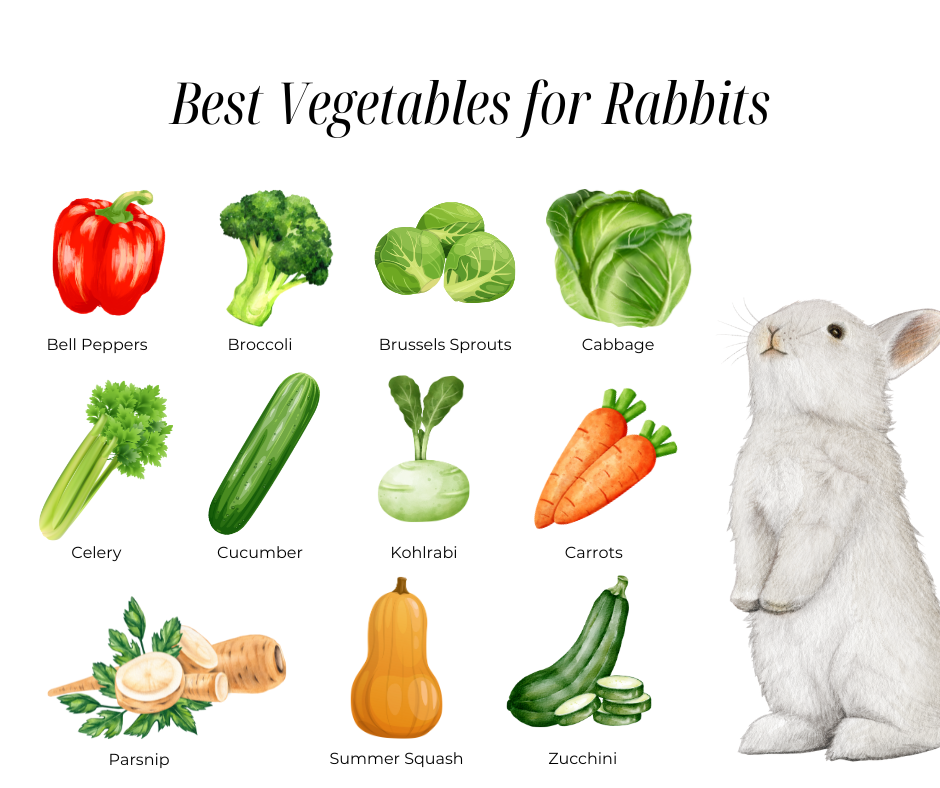
Best Vegetables for Rabbits
Type of Vegetable | Calcium Concentrations (percentage) | Oxalate Concentrations (mg/kg (ppm)) | Note |
| Bell Peppers | 0.020% | 100 | Remove seeds and cap before offering |
| Broccoli leaves and stems | 0.050% | 80 | May cause bloating or gas in rabbits with sensitive stomachs |
| Broccolini | 0.050% | 75 | May cause bloating or gas in rabbits with sensitive stomachs |
| Brussels Sprouts | 0.040% | 100 | May cause bloating or gas in rabbits with sensitive stomachs |
| Cabbage | 0.055% | 25 | May cause bloating or gas in rabbits with sensitive stomachs |
| Carrots (leaves/greens intact) | 0.060% | 300 | High in simple carbohydrates, feed sparingly or as treat only |
| Celery | 0.040% | 100 | Remove veins or cut into chunks |
| Cucumber (with peel) | 0.025% | 0 | |
| Kohlrabi | 0.035% | 0 | |
| Parsnip | 0.040% | 550 | High in simple carbohydrates, feed sparingly or as treat only |
| Summer squash | 0.030% | 25 | |
| Zucchini | 0.030% | 25 |
What Veggies Should Rabbits Avoid?
Avoid feeding rabbits iceberg lettuce, rhubarb, raw onions, leeks, garlic, and any vegetables treated with pesticides. Also avoid high-starch veggies like potatoes and corn, as well as sugary treats like peas.
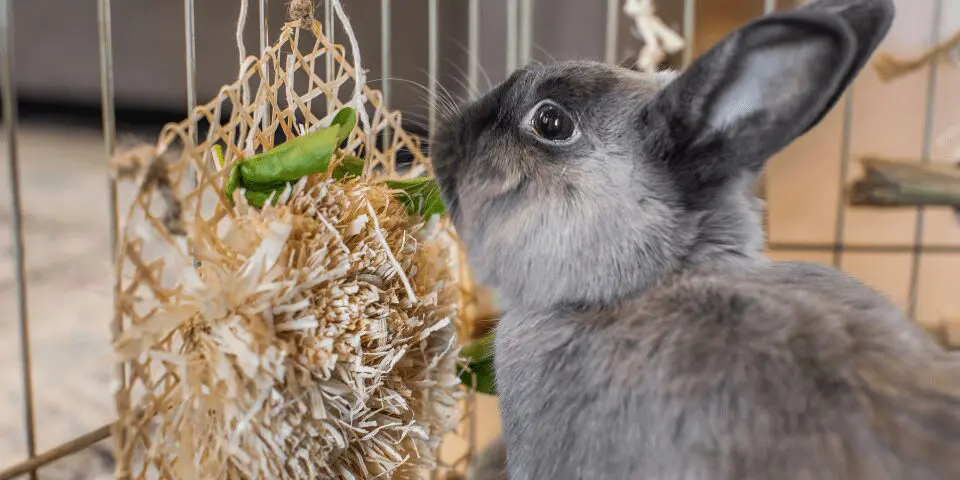
Consider Individual Health Factors Before Offering New Greens or Veggies
As we discussed above, all animals are unique and therefore it is always imperative to factor your fur baby’s medical history into dietary decisions. Some veggies and greens have specific nutritional factors that might determine if they are appropriate for your specific pet.
For example, parsley, spinach, mustard greens, and Swiss chard should be fed sparingly or avoided completely for animals with a history of bladder issues, as these plants are higher in calcium and oxalates than other greens and veggies. Similarly, broccoli, broccolini, Brussels sprouts, and cabbage may cause gastrointestinal discomfort (gas, bloating) in rabbits with sensitive stomachs.
If you have questions about what is best for your individual pet, consult with your veterinarian before making dietary changes. Doing what you can to safely provide a diversity and variety of appropriate greens and veggies can help keep you and your bun happy for years to come.
Rabbit Veggie FAQ
Can rabbits have celery?
Yes, celery is safe in moderation. Remove strings or cut into small chunks to prevent choking.
Can rabbits eat cucumbers?
Yes, cucumbers (with peel) are low-calorie and hydrating. Feed in small portions.
Can rabbits eat broccoli?
Yes, but broccoli can cause gas in sensitive rabbits. Offer leaves and stems sparingly.
Can rabbits eat cabbage?
Cabbage is okay in moderation but may cause bloating. Introduce slowly and watch for GI issues.
Can rabbits eat spinach?
Spinach is high in oxalates and should be fed sparingly, especially for rabbits prone to bladder issues.
Can baby rabbits eat vegetables?
Baby rabbits should primarily have their mother’s milk, then hay and pellets. Introduce veggies slowly after 12 weeks of age.
How often should I feed veggies?
Daily. Aim for 1 cup of greens per 2 pounds of body weight and adjust based on your rabbit’s health and vet advice.
What is a bunny’s favorite food?
Most rabbits love fresh greens like romaine, parsley, and cilantro. Individual preferences vary.
What is the healthiest food for bunnies?
Unlimited grass hay, species-specific pellets, and a rotating selection of leafy greens and veggies make up the healthiest diet.
References
U.S. Department of Agriculture, Agricultural Research Service. FoodData Central, 2019. fdc.nal.usda.gov.

